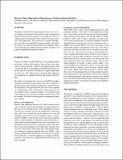| dc.contributor.author | Richardson, Alan | |
| dc.contributor.author | Malcolm, Alison E. | |
| dc.contributor.other | Massachusetts Institute of Technology. Earth Resources Laboratory | |
| dc.date.accessioned | 2014-10-02T14:16:09Z | |
| dc.date.available | 2014-10-02T14:16:09Z | |
| dc.date.issued | 2013 | |
| dc.identifier.uri | http://hdl.handle.net/1721.1/90524 | |
| dc.description.abstract | We propose using the forward propagated source wave to create synthetic receiver data on the surfaces of the computational domain where real receiver data is not available as a means of exploiting known information about reflector locations in Reverse Time Migration. The inclusion of synthetic boundary data can make true amplitude imaging possible, and reduce the artifacts associated with the inclusion of multiples. Here, we describe the new method, present synthetic examples, and propose an appropriate imaging condition. | en_US |
| dc.language.iso | en_US | en_US |
| dc.publisher | Massachusetts Institute of Technology. Earth Resources Laboratory | en_US |
| dc.relation.ispartofseries | Earth Resources Laboratory Industry Consortia Annual Report;2013-33 | |
| dc.subject | Imaging | |
| dc.subject | Migration | |
| dc.title | Reverse Time Migration in the presence of known sharp interfaces | en_US |
| dc.type | Technical Report | en_US |
